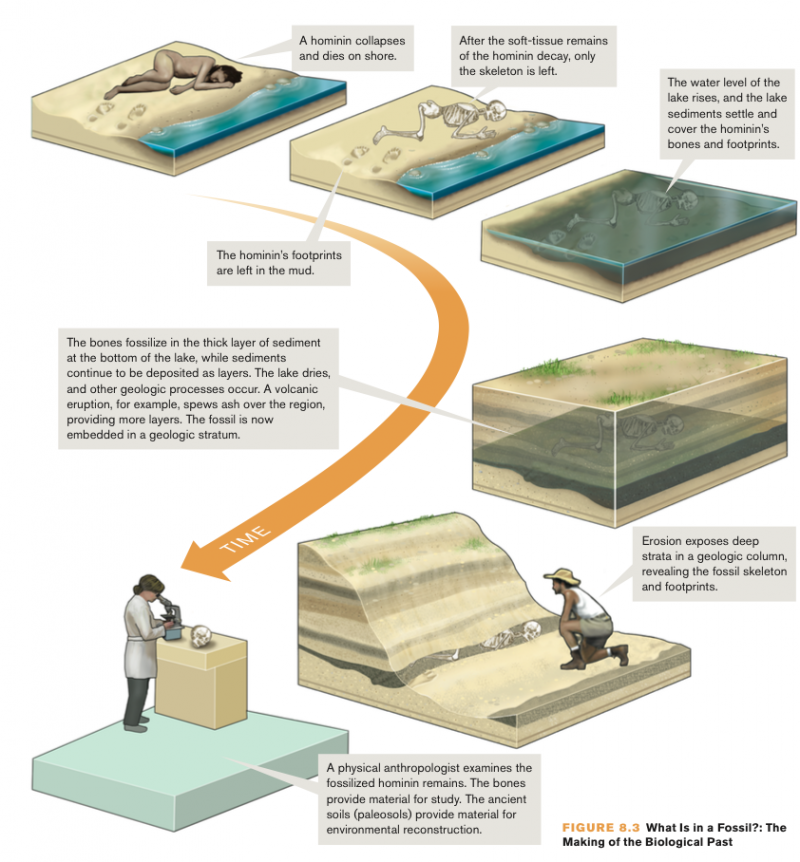Describe the Typical Conditions Necessary for Fossil Formation
The word fossil comes from the Latin word fossus which means dug up. Examples include fossilized tissue excrement egg shells trackways burrows and nests.

Anth 102 Chapter 8 Fossils And Their Place In Time And Nature Flashcards Chegg Com
Plants use the energy in sunlight to make their own food.

. BIUS X X 22 TT body P. Animals live in many environments on Earth but not everywhere. It is hard lustrous and has the highest percentage of carbon among peat lignite bituminous and anthracite.
The process of fossil formation varies depending upon the initial remains and the conditions. Nature of the fossil record 1. For a fossil to form several conditions have to be met.
A cast fossil occurs when the gaping hole in the mold fossil as a result of erosion is filled up with sediment. First of all the animal had to live in the given area. Trace fossils provide humans with indirect evidence of past life.
Freezing drying and encasement such as in tar or resin can create whole-body fossils that preserve bodily tissues. The energy in fossil fuels originally came from the Sun. Answer 1 of 3.
Cold areas also tend to have fewer scavengers insects and bacteria that would accelerate a. The process of fossilization 3. Wet rainy weather to let there be mud that usually is hard rock dirt an animal steps in.
Generally the remains were once the hard parts of an organism such as bones and shell although under exceptional circumstances soft tissues have also fossilised. Conditions needed for fossil formation. Although all of the produced materials begin as organic material and are transformed over a large time span due to burial by sediment pressure and temperature different conditions result in the.
Conditions conducive to the formation of fossils include quick burial in moist sediment or other material that tends to prevent weathering and to exclude oxygen and bacteria thereby preventing decay. Results when horizontal layers cover titled erored layers. Consider the billions of plants and animals that have died since life began on our marvelous planet and yet how relatively few fossils we have.
Develops when horizontal rock layers are exposed and erored and new horizontal layers of rocks r deposited on the erored surface. Shells and bones embedded in sediment in past geologic time under conditions suitable for preservation left exact reproductions of both external and internal structures. Rapid burial under large amounts of sediments prevents the decay of the organic material.
Body fossils and trace fossils 2. Related Discussions- fossils Air pollution by carbon monoxide Air pollution by Carbon monoxide. Fossils are the remains of once living things.
Fossil formation occurs when some trace of organic life whether it be a footprint or an actual foot is preserved beyond the original organisms decomposition. It is formed due to the high pressure and high temperature for a long period of time. The fossil is found due to the process by which all other fossils are revealed - erosion.
Why are typical conditions necessary for fossil formation. In general cold dry conditions are more conducive to fossil preservation than warm moist conditions. Describe the typical conditions necessary for fossil formation.
A foot print a leaf or any other fossil needs to have some erosion involved in bringing it back to the surface so it can be found. Fossil fuel formation refers to the process that takes place over the time span of hundreds of millions of years to produce a variety of fossil fuels including coal oil and natural gas. Find an answer to your question Prompt Describe the typical conditions necessary for fossil formation.
Completeness of the fossil recordTwo fundamental natural factors govern the process of fossilizationThe environment where an organism diedThe materials that made up the organisms body when it was aliveFossilization. The suitable conditions for the formation of the fossils The organism body must be buried immediately after death in a medium that preserves it from the decomposition The organism must have a hard skeleton The suitable medium must be found in which the mineral material replaces the organic material of the living organism. Organic matter is decomposed rapidly when exposed to air and bacteria.
You can learn about these processes in the lesson Food Webs Some energy remains in plants and animals that die and become fossil fuels. Fossil are the remainsimprintsor traces of past organismsfossilization is most likely if the organism had hard parts andwasburied. The energy in plants passes to the animals that eat the plants.
Petroleum and natural gas deposits are usually found in the coastal regions. How do I describe the typical conditions necessary for fossil formation. The water above many lake bottoms and many areas of the deep ocean bottom are stagnant.
This is also called as hard coal. Fossil formation is not a simple process. Protection from scavengers Quick burial by sediments Hard Parts.
They are tracks left behind by animals or plants. This refers to the fact that fossils are the remains of past life preserved in rock soil or amber. Rapid burial in a marine environment where there is a lot of calcium carbonate to act as cement and other minerals.
Types of fossil preservation 4. What conditions needed for fossil formation. A cast fossil is 3 dimensional while a mold must be present for a cast fossil to occur.
The overlying sediments are stripped away.

Fossil Butterfly Wall Decor Etsy Fossil Art Butterfly Wall Butterfly Wall Decor

Science Fair Coming Up Science Fair School Projects School Daze

Comments
Post a Comment